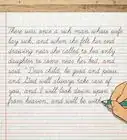This article was co-authored by Kelly Medford. Kelly Medford is an American painter based in Rome, Italy. She studied classical painting, drawing and printmaking both in the U.S. and in Italy. She works primarily en plein air on the streets of Rome, and also travels for private international collectors on commission. She founded Sketching Rome Tours in 2012 where she teaches sketchbook journaling to visitors of Rome. Kelly is a graduate of the Florence Academy of Art.
There are 9 references cited in this article, which can be found at the bottom of the page.
This article has been viewed 20,390 times.
There are many ways to teach art, but it’s generally best to start with fun, easy projects. When teaching children, assign projects with easy, familiar subjects or open-ended art challenges. Demonstrate the projects yourself to inspire and engage students. For high school art classes, create an engaging balance of instruction, hands-on projects, and art history. When teaching art workshops for adults, focus on creating a relaxed, social environment and provide straightforward instructions to follow, resulting in a finished product to take home. For all ages, give lots of affirmation and encouragement to create a positive, creative environment.
Steps
Working with Young Children (Ages 6-12)
-
1Use washable paints and markers instead of pencils and erasers. Using broader, messier materials encourages openness and creativity. Pencils and erasers will make the process take much longer and lead the kids to constantly erase their mistakes.[1] Provide a wide variety of children’s paints and markers for kids to choose from.
- Using paints and markers will also encourage the kids to work faster and create a higher volume of work.
-
2Pick fun, familiar subject for kids to draw or paint. A sense of familiarity with the subject will give kids the confidence they need to start a new project. For example, you would choose something that the kids may have seen or drawn before, such as a bouquet of flowers in a vase or a cat. You wouldn’t choose a piece of obscure architecture or a person they’ve never heard of.[2]Advertisement
-
3Demonstrate the projects yourself. When kids see the teacher drawing or painting too, they tend to engage with the lesson more fully. Use a large piece of paper, a whiteboard, or a projector to show the kids how you would draw the subject. Practice drawing it beforehand and, if you can, show several different styles. Showing the students your artistic skills will inspire and encourage them.[3]
- For example, you could draw an extremely simplified version, a more realistic version, and a cartoonish version.
- However, always encourage students to make the drawing their own. Your drawing should be a demonstration, not a reference.[4]
-
4Try some open-ended projects with kids who are 8 and up. Challenge the students to create a painting of a memory or draw a scene from their favorite book. This project style will teach students how to combine imagination, memory, and creativity. You’ll also see a more diverse response from the class, which can lead to a fun share-and-respond session.[5]
- You could assign projects like “draw what you did over summer vacation,” or “make a portrait out of unconventional materials.”
- This will also challenge kids to draw from imagination rather than observation.
- Kids who are 8 or older are likely to engage with this project best. However, if you have younger students that could tackle the project, feel free to try it with them.
-
5Encourage students frequently and give positive feedback. Focus on improvements and successes, centering your encouragement around hard work rather than talent.[6] If children hear criticism, they’re more likely to give up. Instead of judgment, use positive encouragements and questions to help them notice things about their drawing.[7]
- For example, you could give affirmations like “Wow, the shapes you chose look really great together!” or “You’re doing a great job at staying focused.”
- If you notice that a student has drawn something unusual or out of scale, such as a person with huge feet, you could ask them something like “Can you tell me more about the feet?” Asking them to elaborate can give you a better idea of how they observe and translate observation to paper.
Teaching a High School Art Class
-
1Plan out your lessons in advance to introduce new ideas and skills. Whether you plan weeks in advance or the night before class, you should always have a schedule prepared for class time. Include several basic elements in each lesson plan, such as an opening warm-up, a short review session, and the main assignment.[8]
- Use an opening warm-up or ritual to help the students focus their attention and warm up, such as a few minutes of quiet contour drawing or sketching.
- Include a short review session at the beginning of each lesson to remind students of what they’ve learned already. During this time, ask students if they have any questions about previous lessons or techniques.
- The main assignment should take up the bulk of the class time. Start by introducing any new techniques that students will need to complete the assignment, then explain the assignment details before letting students begin working on it.
-
2Incorporate skills that students will use later in life. Emphasize basic design principles, such as balance and composition, and the importance of having a foundational knowledge of art. If your students plan to attend college or enter the job market, they’ll benefit immensely from a background in art history or artistic skills.
- Other important basic artistic skills include working with lines, shapes, colors, values, and textures.
- For example, your students will need a solid background in design principles for a college degree in graphic design, interior design, or visual communications.
- They could also apply these skills in the workplace when designing a logo, making promotional brochures, or creating visually compelling emails.
-
3Ground your lessons by touching on some art history. Whether you include some art history in every class period or dedicate a single class period to it, this side of art is crucial to creating a well-rounded class experience. To incorporate art history into your course, match an iconic art movement with the lessons you’ll be teaching. Summarize the style, its most popular artists, and its historical significance.
- For example, you could introduce pop art with a lesson on color theory or portraiture.
- You could pair a section on abstract art with a lesson on how to create balance in a composition.[9]
-
4Incorporate hands-on projects in each class. This is a great way to keep students engaged and help them progress in skill. Explain the project, then let your students practice the techniques you’ve explained. Walk around the room, giving encouragement and correcting any major mistakes to help students get back on track.
- For example, you could set up a still life in the classroom with a bowl of fruit or a series of glass bottles. Have students draw, paint, or photograph the scene in class to hone their skills.
-
5Assign homework each week. This could be a project to work on outside of class, a journal for recording inspiration, or special challenges for students to complete each day. Having regular homework outside of classwork will help students retain information and learn how to practice these skills on their own.
- For pottery classes, you could have students sketch their favorite mugs in detail.
- For a drawing class, assign blind contours and action poses to let students practice and get used to the feeling of drawing.
-
6Plan field trips to introduce students to fine art and inspiration. Excursions to art museums, studios, and galleries can be a great way to expose students to new styles and get them excited about art. Observation is key to developing a critical eye and an appreciation for art.
- To get more hands-on, you could arrange for a tour or a presentation with a local artist.
- You could also include an assignment with the trip, such as a paragraph on their favorite piece.
-
7Give encouraging feedback as well as 1-2 suggestions for improvement. Each teacher grades differently, but encouragement is key for keeping your students working hard. Give feedback for each assignment students turn in and limit your corrections to 1 or 2 suggestions. Encourage students' creativity above all!
- For example, when giving feedback on an abstract piece, you could say, "Your sense of balance and composition is really strong. You've done a great job with this project. My only note is that contrasting colors could add a little more interest to the piece—try out some complementary colors next time and see what you think."
- If you do class critiques, make sure to affirm your students on what they did well and keep things positive. Remember that feedback can be nerve-wracking, especially in front of the whole class!
Instructing a Workshop for Adults
-
1Choose a simple, fun project that can be completed in about an hour. Plan out your full project beforehand, taking care to choose a subject that will look good and be fairly easy to replicate. Break the project down, step by step, to create a simple process for the class to follow. Make sure to bring your reference, whether a photograph or your own painting, to class for students to follow.
- Simple but beautiful scenes in nature are often favorites for painting workshops. You could choose a scene such as a boat on a lake at sunset, for instance.
-
2Plan out your time so students can finish a full piece of artwork. Satisfaction is a huge part of having fun with art, and ending the class with an unfinished piece of artwork can be incredibly unsatisfying for students. Practice the painting and make sure that it will suit the length of the class. Then plan out your time efficiently, taking into account different students’ paces and abilities.[10]
- This way, they’ll feel accomplished and have something to take home and show their family. This is one of the best ways to spread the word about your class.
-
3Include some technical skills to make the class informative and fun. Along with encouraging creativity and play, you should teach some new skills in the workshop. Incorporate some basic techniques into each project and demonstrate the technique to the class before starting the project.[11]
- For example, if you’re teaching a watercolor workshop, you could teach dry brush and spatter techniques by painting subjects like a waterfall or a rainy street.
- You could also encourage your students to keep a “cheat sheet” of notes as they learn new skills.
-
4Create a relaxed, social environment. Adult art workshops are generally more socially focused. Oftentimes, a “paint and pour” format with some instruction and complimentary wine works well for workshops. Workshops should feel less structured than classes, giving the adults time to socialize as well as instruction.[12]
- For example, you could periodically demonstrate each step on your own easel at the front of the class, and then give everyone enough time to work on that step and talk to each other.
- To create a calm, inviting environment, you could also set up the easels in a circle and have some relaxed, warm lighting.
-
5Provide the art supplies if the class is for beginners. New students likely won’t have any supplies of their own, so make sure to provide the supplies each student will need to complete a project. Figure the cost of the supplies into the price of the workshop and have all the supplies set up when the students arrive.[13]
- For example, painting workshops should have an easel, paints, canvas or paper, brushes, and jars of water for each person. Pottery classes may need clay, water, sponges, shaping tools, and wheels, depending on the techniques used.
- You can either let the students take the supplies home or keep the supplies to use for future workshops.
-
6Keep the class size small so you can focus on each student. When you start teaching workshops, you should start small and expand as you gain experience. Start with 2-3 students and learn how to balance one-on-one time for questions with class demonstration time. As you continue teaching and find that you can handle more students, add more slots to your classes.[14]
- Generally, you should limit your classes to a maximum of 10 people.
-
7Give lots of encouragement and affirmation. By the time they reach adulthood, most people believe they are not “artistic.” It’s important to give your students confidence in their abilities and the progress they’ve made by affirming them. Compliment them on the techniques they get right during the creative process and when they’ve finished their project.[15]
- For example, you could say “Your brushstrokes here are perfect” or “You’ve done a great job at capturing the shadows.”
- Make sure to also emphasize that there is no competition or comparison in the workshop. Let people work at their own pace and remind everyone that there is no right or wrong way to approach the creative process.
Expert Q&A
Did you know you can get expert answers for this article?
Unlock expert answers by supporting wikiHow
-
QuestionWhat makes a good art teacher?
 Kelly MedfordKelly Medford is an American painter based in Rome, Italy. She studied classical painting, drawing and printmaking both in the U.S. and in Italy. She works primarily en plein air on the streets of Rome, and also travels for private international collectors on commission. She founded Sketching Rome Tours in 2012 where she teaches sketchbook journaling to visitors of Rome. Kelly is a graduate of the Florence Academy of Art.
Kelly MedfordKelly Medford is an American painter based in Rome, Italy. She studied classical painting, drawing and printmaking both in the U.S. and in Italy. She works primarily en plein air on the streets of Rome, and also travels for private international collectors on commission. She founded Sketching Rome Tours in 2012 where she teaches sketchbook journaling to visitors of Rome. Kelly is a graduate of the Florence Academy of Art.
Professional Artist Encourage children not to compare their art to other people's. Art is a natural human expression, and it comes really naturally to most kids. At some point, maybe around age 8 or 9, kids start to compare themselves to other people and they get self-conscious. They might feel like they're not good at it or that their picture is supposed to look a certain way. That's why it's really important to encourage them to keep trying.
Encourage children not to compare their art to other people's. Art is a natural human expression, and it comes really naturally to most kids. At some point, maybe around age 8 or 9, kids start to compare themselves to other people and they get self-conscious. They might feel like they're not good at it or that their picture is supposed to look a certain way. That's why it's really important to encourage them to keep trying. -
QuestionHow can I make my art class interesting?
 Kelly MedfordKelly Medford is an American painter based in Rome, Italy. She studied classical painting, drawing and printmaking both in the U.S. and in Italy. She works primarily en plein air on the streets of Rome, and also travels for private international collectors on commission. She founded Sketching Rome Tours in 2012 where she teaches sketchbook journaling to visitors of Rome. Kelly is a graduate of the Florence Academy of Art.
Kelly MedfordKelly Medford is an American painter based in Rome, Italy. She studied classical painting, drawing and printmaking both in the U.S. and in Italy. She works primarily en plein air on the streets of Rome, and also travels for private international collectors on commission. She founded Sketching Rome Tours in 2012 where she teaches sketchbook journaling to visitors of Rome. Kelly is a graduate of the Florence Academy of Art.
Professional Artist Allow kids to blend real-world and imaginative images. Kids love to draw from their imagination, while they typically have to be taught how to draw the things they see around them. One way to keep them engaged is to work with them to draw from observation, but then allow them to use their imagination at the same time.
Allow kids to blend real-world and imaginative images. Kids love to draw from their imagination, while they typically have to be taught how to draw the things they see around them. One way to keep them engaged is to work with them to draw from observation, but then allow them to use their imagination at the same time. -
QuestionHow do you introduce art to kids?
 Kelly MedfordKelly Medford is an American painter based in Rome, Italy. She studied classical painting, drawing and printmaking both in the U.S. and in Italy. She works primarily en plein air on the streets of Rome, and also travels for private international collectors on commission. She founded Sketching Rome Tours in 2012 where she teaches sketchbook journaling to visitors of Rome. Kelly is a graduate of the Florence Academy of Art.
Kelly MedfordKelly Medford is an American painter based in Rome, Italy. She studied classical painting, drawing and printmaking both in the U.S. and in Italy. She works primarily en plein air on the streets of Rome, and also travels for private international collectors on commission. She founded Sketching Rome Tours in 2012 where she teaches sketchbook journaling to visitors of Rome. Kelly is a graduate of the Florence Academy of Art.
Professional Artist Show them art in books, online, and in the real world. Teach children that art can be a career choice. For a lot of kids, no adult has ever told them that being an artist can be a profession. I think it's important to take children to museums, have them look at art and talk about it, and then have them make drawings and paintings based on the art they see.
Show them art in books, online, and in the real world. Teach children that art can be a career choice. For a lot of kids, no adult has ever told them that being an artist can be a profession. I think it's important to take children to museums, have them look at art and talk about it, and then have them make drawings and paintings based on the art they see.
Things You’ll Need
- Reference photo or project
- Art supplies
- Smocks
References
- ↑ https://www.deepspacesparkle.com/top-eight-tips-for-teaching-art-to-children/
- ↑ https://www.deepspacesparkle.com/top-eight-tips-for-teaching-art-to-children/
- ↑ https://www.deepspacesparkle.com/top-eight-tips-for-teaching-art-to-children/
- ↑ https://www.goshen.edu/art/ed/draw.html
- ↑ https://www.theartofed.com/2015/10/12/3-ways-to-teach-for-creativity-in-the-art-room/
- ↑ http://thevirtualinstructor.com/blog/how-to-teach-visual-art-effectively
- ↑ https://www.goshen.edu/art/ed/draw.html
- ↑ https://www.goshen.edu/art/ed/artlsn.html
- ↑ https://artclasscurator.com/abstract-art-lesson/
- ↑ https://www.artworkarchive.com/blog/preparing-to-teach-your-first-artist-workshop
- ↑ https://www.artworkarchive.com/blog/preparing-to-teach-your-first-artist-workshop
- ↑ http://www.artbusiness.com/workshops.html
- ↑ http://www.artbusiness.com/workshops.html
- ↑ http://www.artbusiness.com/workshops.html
- ↑ http://classroom.synonym.com/teach-art-adults-5072818.html
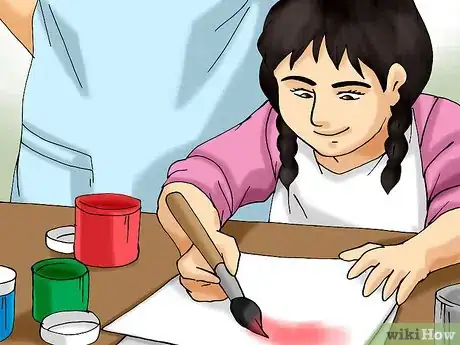











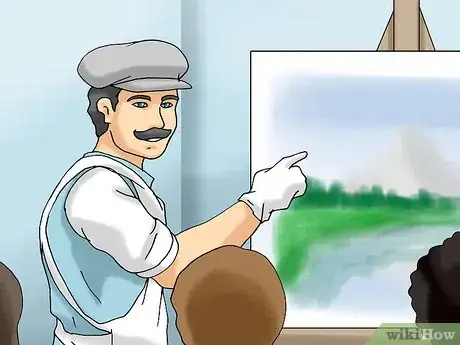
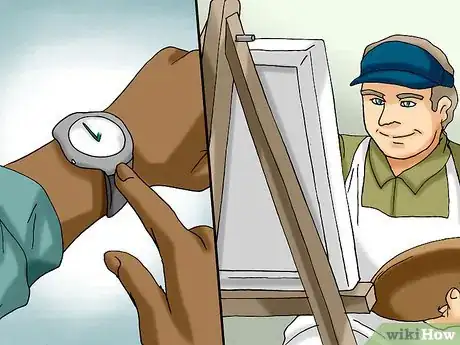
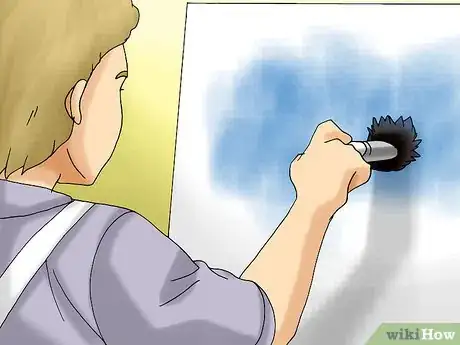

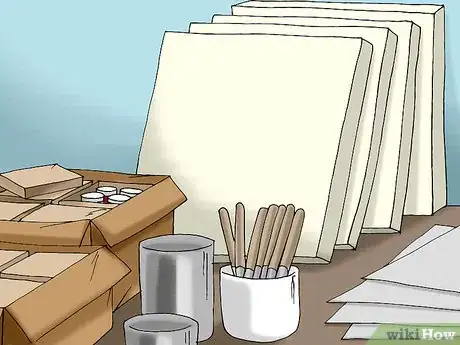
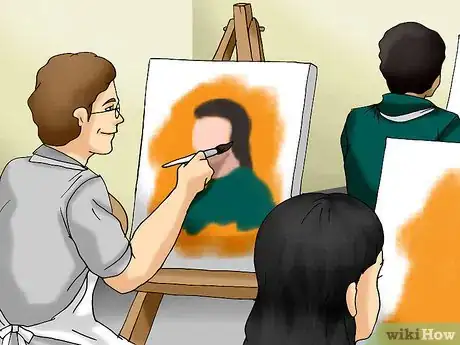






-Step-15.webp)

















